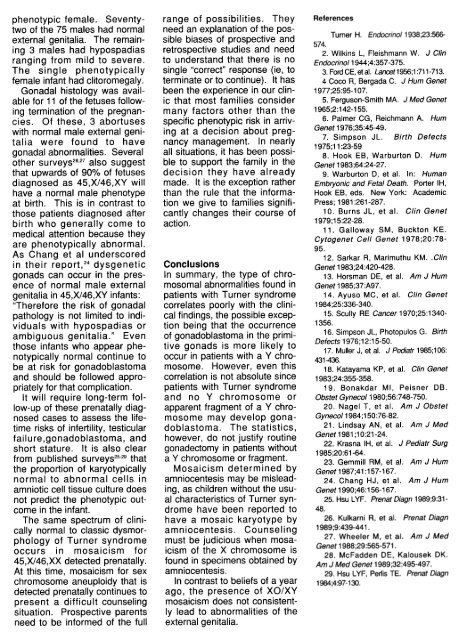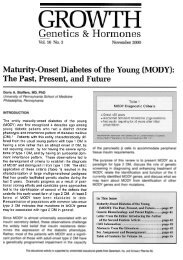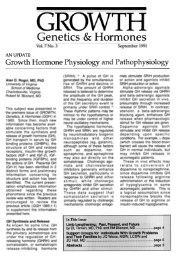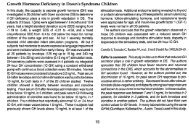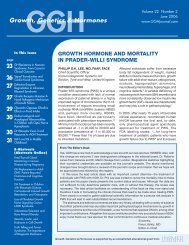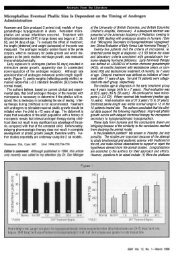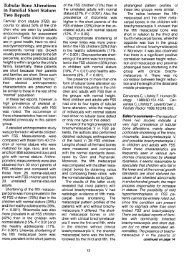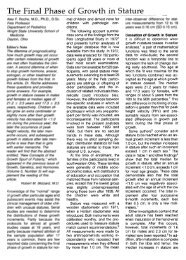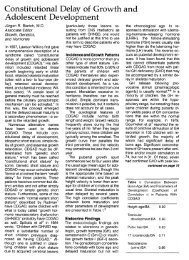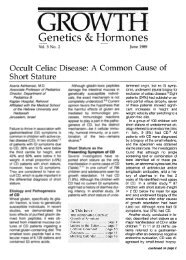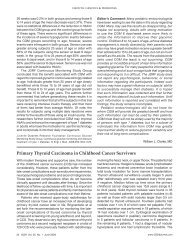Mosaicism in Turner Syndrome - GGH Journal
Mosaicism in Turner Syndrome - GGH Journal
Mosaicism in Turner Syndrome - GGH Journal
Create successful ePaper yourself
Turn your PDF publications into a flip-book with our unique Google optimized e-Paper software.
phenotypic female. Seventytwo<br />
of the 75 males had normal<br />
external genitalia. The rema<strong>in</strong><strong>in</strong>g<br />
3 males had hypospadias<br />
rang<strong>in</strong>g from mild to severe.<br />
The s<strong>in</strong>gle phenotypically<br />
female <strong>in</strong>fant had clitoromegaly.<br />
Gonadal histology was available<br />
for 11 of the fetuses follow<strong>in</strong>g<br />
term<strong>in</strong>ation of the pregnancies.<br />
Of these, 3 abortuses<br />
with normal male external genitalia<br />
were found to have<br />
gonadal abnormalities. Several<br />
other surveys26,27 also suggest<br />
that upwards of 90% of fetuses<br />
diagnosed as 45,X/46,XY will<br />
have a normal male phenotype<br />
at birth. This is <strong>in</strong> contrast to<br />
those patients diagnosed after<br />
birth who generally come to<br />
medical attention because they<br />
are phenotypically abnormal.<br />
As Chang et al underscored<br />
<strong>in</strong> their report,24 dysgenetic<br />
gonads can occur <strong>in</strong> the presence<br />
of normal male external<br />
genitalia <strong>in</strong> 45,X/46,XY <strong>in</strong>fants:<br />
"Therefore the risk of gonadal<br />
pathology is not limited to <strong>in</strong>dividuals<br />
with hypospadias or<br />
ambiguous genitalia." Even<br />
those <strong>in</strong>fants who appear phenotypically<br />
normal cont<strong>in</strong>ue to<br />
be at risk for gonadoblastoma<br />
and should be followed appropriately<br />
for that complication.<br />
It will require long-term follow-up<br />
of these prenatally diagnosed<br />
cases to assess the lifetime<br />
risks of <strong>in</strong>fertility, testicular<br />
failure,gonadoblastoma, and<br />
short stature. It is also clear<br />
from published surveys25-29 that<br />
the proportion of karyotypically<br />
normal to abnormal cells <strong>in</strong><br />
amniotic cell tissue culture does<br />
not predict the phenotypic outcome<br />
<strong>in</strong> the <strong>in</strong>fant.<br />
The same spectrum of cl<strong>in</strong>ically<br />
normal to classic dysmorphology<br />
of <strong>Turner</strong> syndrome<br />
occurs <strong>in</strong> mosaicism for<br />
45,X/46,XX detected prenatally.<br />
At this time, mosaicism for sex<br />
chromosome aneuploidy that is<br />
detected prenatally cont<strong>in</strong>ues to<br />
present a difficult counsel<strong>in</strong>g<br />
situation. Prospective parents<br />
need to be <strong>in</strong>formed of the full<br />
range of possibilities. They<br />
need an explanation of the possible<br />
biases of prospective and<br />
retrospective studies and need<br />
to understand that there is no<br />
s<strong>in</strong>gle "correct" response (ie, to<br />
term<strong>in</strong>ate or to cont<strong>in</strong>ue). It has<br />
been the experience <strong>in</strong> our cl<strong>in</strong>ic<br />
that most families consider<br />
many factors other than the<br />
specific phenotypic risk <strong>in</strong> arriv<strong>in</strong>g<br />
at a decision about pregnancy<br />
management. In nearly<br />
all situations, it has been possible<br />
to support the family <strong>in</strong> the<br />
decision they have already<br />
made. It is the exception rather<br />
than the rule that the <strong>in</strong>formation<br />
we give to families significantly<br />
changes their course of<br />
action.<br />
Conclusions<br />
In summary, the type of chromosomal<br />
abnormalities found <strong>in</strong><br />
patients with <strong>Turner</strong> syndrome<br />
correlates poorly with the cl<strong>in</strong>ical<br />
f<strong>in</strong>d<strong>in</strong>gs, the possible exception<br />
be<strong>in</strong>g that the occurrence<br />
of gonadoblastoma <strong>in</strong> the primitive<br />
gonads is more likely to<br />
occur <strong>in</strong> patients with a V chromosome.<br />
However, even this<br />
correlation is not absolute s<strong>in</strong>ce<br />
patients with <strong>Turner</strong> syndrome<br />
and no V chromosome or<br />
apparent fragment of a V chromosome<br />
may develop gonadoblastoma.<br />
The statistics,<br />
however, do not justify rout<strong>in</strong>e<br />
gonadectomy <strong>in</strong> patients without<br />
a V chromosome or fragment.<br />
<strong>Mosaicism</strong> determ<strong>in</strong>ed by<br />
amniocentesis may be mislead<strong>in</strong>g,<br />
as children without the usual<br />
characteristics of <strong>Turner</strong> syndrome<br />
have been reported to<br />
have a mosaic karyotype by<br />
amniocentesis. Counsel<strong>in</strong>g<br />
must be judicious when mosaicism<br />
of the X chromosome is<br />
found <strong>in</strong> specimens obta<strong>in</strong>ed by<br />
amniocentesis.<br />
In contrast to beliefs of a year<br />
ago, the presence of XC/XV<br />
mosaicism does not consistently<br />
lead to abnormalities of the<br />
external genitalia.<br />
References<br />
<strong>Turner</strong> H. Endocr<strong>in</strong>o/1938;23:566-<br />
574.<br />
2. Wilk<strong>in</strong>s L, Fleishmann W. J Cl<strong>in</strong><br />
Endocr<strong>in</strong>o/1944;4:357-375.<br />
3. Ford CE, etal. Lancet 1956;1 :711-713.<br />
4 Coco R, Bergada C. J Hum Genet<br />
1977;25:95-107.<br />
5. Ferguson-Smith MA. J Med Genet<br />
1965;2:142-155.<br />
6. Palmer CG, Reichmann A. Hum<br />
Genet 1976;35:45-49.<br />
7. Simpson JL. Birth Defects<br />
1975;11 :23-59<br />
8. Hook EB, Warburton D. Hum<br />
Genet 1983;64:24-27.<br />
9. Warburton D, et al. In: Human<br />
Embryonic and Fetal Death. Porter IH,<br />
Hook EB, eds. New York: Academic<br />
Press; 1981:261-287.<br />
10. Burns JL, et al. Cl<strong>in</strong> Genet<br />
1979;15:22-28.<br />
11. Galloway SM, Buckton KE.<br />
Cytogenet Cell Genet 1978;20:78-<br />
95.<br />
12. Sarkar R, Marimuthu KM. .C/<strong>in</strong><br />
Genet 1983;24:420-428.<br />
13. Horsman DE, et al. Am J Hum<br />
Genet 1985;37:A97.<br />
14. Ayuso MC, et al. C/<strong>in</strong> Genet<br />
1984;25:336-340.<br />
15. Scully RE Cancer 1970;25:1340-<br />
1356.<br />
16. Simpson JL, Photopulos G. Birth<br />
Defects 1976;12:15-50.<br />
17. Muller J, et aI. J Pediatr 1985;106:<br />
431-436.<br />
18. Katayama KP, et al. C/<strong>in</strong> Genet<br />
1983;24:355-358.<br />
19. Bonakdar MI, Peisner DB.<br />
Obstet Gyneco/1980;56:748-750.<br />
20. Nagel T, et al. Am J Obstet<br />
Gyneco/1984;150:76-82.<br />
21. L<strong>in</strong>dsay AN, et al. Am J Med<br />
Genet 1981;10:21-24.<br />
22. Krasna IH, et al. J Pediatr Surg<br />
1985;20:61-64.<br />
23. Gemmill RM, et al. Am J Hum<br />
Genet 1987;41 :157-167.<br />
24. Chang HJ, et al. Am J Hum<br />
Genet 1990;46:156-167.<br />
25. Hsu L YF. Prenat Diagn 1989;9:31-<br />
48.<br />
26. Kulkarni R, et al. Prenat Diagn<br />
1989;9:439-441.<br />
27. Wheeler M, et al. Am J Med<br />
Genet 1988;29:565-571.<br />
28. McFadden DE, Kalousek DK.<br />
Am J Med Genet 1989;32:495-497.<br />
29. Hsu LYF, Perl is TE. Prenat Diagn<br />
1984;4:97-130.


